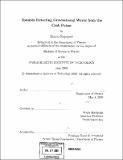| dc.contributor.advisor | Nergis Mavalvala. | en_US |
| dc.contributor.author | Rapoport, Sharon, S.B. Massachusetts Institute of Technology | en_US |
| dc.contributor.other | Massachusetts Institute of Technology. Dept. of Physics. | en_US |
| dc.date.accessioned | 2010-02-09T16:48:50Z | |
| dc.date.available | 2010-02-09T16:48:50Z | |
| dc.date.copyright | 2009 | en_US |
| dc.date.issued | 2009 | en_US |
| dc.identifier.uri | http://hdl.handle.net/1721.1/51592 | |
| dc.description | Thesis (S.B.)--Massachusetts Institute of Technology, Dept. of Physics, 2009. | en_US |
| dc.description | Includes bibliographical references (leaf 47). | en_US |
| dc.description.abstract | A variety of fundamental and technical noise sources impact the ability of the Laser Interferometer Gravitational-Wave Observatory (LIGO) to directly detect gravitational radiation. Noteworthy examples include Newtonian gravity gradient, seismic, acoustic, thermal and photon shot noise. These are the obstacles that must be confronted by the planned upgrade to the LIGO detectors, Advanced LIGO. To achieve improved sensitivity, significant improvements of LIGO's hardware must be paralleled by equivalent advances in the digital realm. Using adaptive filtering techniques, it is possible to cancel noise from known sources. We present results showing successful suppression of power line noise at 60Hz by a factor of 500 using commonly available sensors and standard FIR filters. Attenuation of 60Hz noise is particularly important to LIGO due to the 59.7 Hz radiation frequency of the Crab pulsar. Application of the techniques developed in this work to the LIGO detectors promises to improve the signal to noise ratio at the Crab frequency and thus pave the way toward direct detection of gravitational radiation from a known source. | en_US |
| dc.description.statementofresponsibility | by Sharon Rapoport. | en_US |
| dc.format.extent | 47 leaves | en_US |
| dc.language.iso | eng | en_US |
| dc.publisher | Massachusetts Institute of Technology | en_US |
| dc.rights | M.I.T. theses are protected by
copyright. They may be viewed from this source for any purpose, but
reproduction or distribution in any format is prohibited without written
permission. See provided URL for inquiries about permission. | en_US |
| dc.rights.uri | http://dspace.mit.edu/handle/1721.1/7582 | en_US |
| dc.subject | Physics. | en_US |
| dc.title | Towards detecting gravitational waves from the Crab Pulsar | en_US |
| dc.type | Thesis | en_US |
| dc.description.degree | S.B. | en_US |
| dc.contributor.department | Massachusetts Institute of Technology. Department of Physics | |
| dc.identifier.oclc | 495349428 | en_US |
